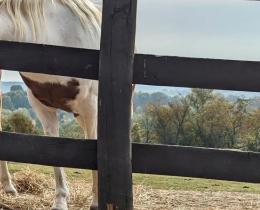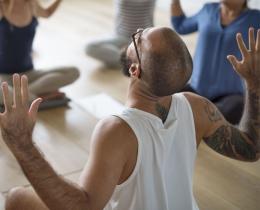Walking meditation is a grounding and steadying mindfulness activity that gives your child access to something that she can do anytime and anyplace when she needs to tune in to her own body and mind. It is a simple but supportive practice. The repetitive movement is soothing, and for many children the movement helps to quiet their minds. This is best done without shoes on.
- Start off by getting grounded and connecting to your feet in mountain pose. Stand in a tall and strong but also comfortable and relaxing position, with your feet hip-width apart.
- Make sure your shoulders are relaxed and take a few deep breaths.
- Notice how your feet feel on the ground. Try moving your weight around a little to see how it feels. Lean forward and backward, then side to side. Then find the center—the place where you are balanced and most strong.
- Begin taking a slow walk. If you are using a yoga mat, a good walking meditation path is to just walk from one end of the mat to the other and then turn around and walk back. Another great option is to do this outside in a safe place (grass is wonderful). If you aren’t using a mat, you can walk a short path in any room and then turn around and walk back to where you started.
- Start to notice how your feet feel as you walk. What is the sensation like in your heels? In your toes?
- After a few moments, start to notice what walking feels like in the rest of your body. What happens in your legs and hips when you walk? What about your arms? Can you feel walking in your neck and your face?
- Try to practice your walking long enough to notice the rhythm of your walk.
- If your mind starts to wander while you are taking your walk, that’s no problem. Just notice where it is wandering to and then gently bring it back to how your body is feeling during your walk.
- When you are ready to finish your mindful walk, come back into mountain pose just like you started. Take a deep breath and send a thank-you thought to your feet.
Follow-up Mindful walking is a great way for children to tune in to the sensations in their physical body. In fact, there are many other activities that your child does that can be similarly explored. Ask your child what it might feel like to mindfully take a ride on a swing, or to jump rope, or take a shower. Some children appreciate knowing that learning to tune in to their bodies while moving can help them become a better athlete.
Challenges If this practice is a struggle for your child, you can invite him to walk in more playful ways. Ask, “What does it feel like to walk on your heels? On your toes? On the outside edges of your feet?” By changing the experience we increase engagement and ease of focus; however, as your child learns this activity, slowly reduce the amount of time spent walking playfully and reintroduce the simple mindful walk.
Daily Practice As a daily practice, mindful walking keeps us grounded in our present experience and helps us stay connected to our bodies. It is best to give children (and yourself) a concrete and attainable goal. Try to get in the habit of making your first walk when you leave the house a mindful one. Setting an intention to walk mindfully to the car or school bus in the morning can have a powerful impact on the rest of your day.



